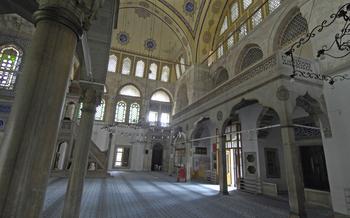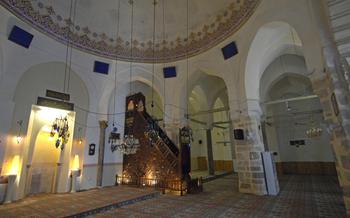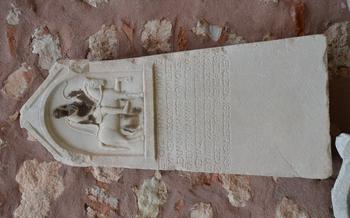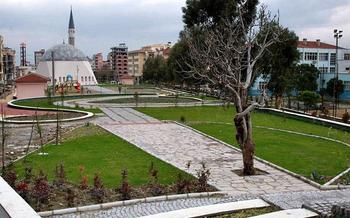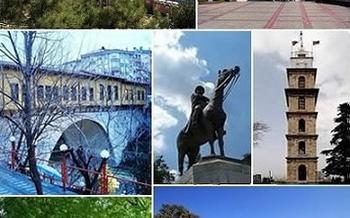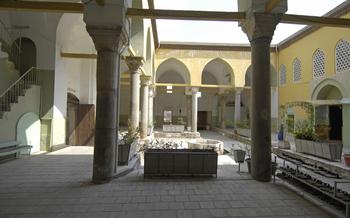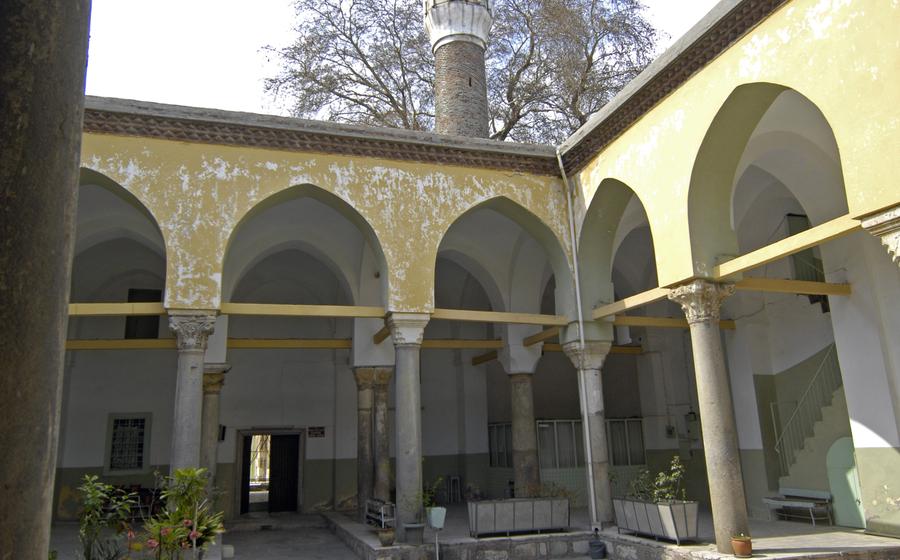
The Ulu Cami (Grand Mosque)
- The Ulu Cami (Grand Mosque): A Timeless Masterpiece
- Captivating Courtyards: A Haven of Tranquility
- Minaret Marvels: A Testimony to Architectural Ingenuity
- Prayer Hall Serenity: A Place of Worship and Reflection
- Historical Context: A Journey Through Time
- Restoration and Preservation: A Labor of Love
- Local Legends and Folklore: Unveiling the City's Soul
- Significance in Islamic Architecture: A Regional Gem
- Visiting Hours and Etiquette: A Respectful Approach
- Location and Accessibility: Finding Your Way
- Nearby Attractions: Exploring Manisa's Treasures
- Photography and Social Media: Capturing the Essence
- Local Customs and Traditions: A Respectful Immersion
- Off-the-Beaten-Path Gems: Uncovering Hidden Treasures
- Insider Tip: A Secret Spot for Contemplation
The Ulu Cami (Grand Mosque): A Timeless Masterpiece
Amidst the bustling city of Manisa, Turkey, stands the magnificent Ulu Cami (Grand Mosque), a testament to the region's rich history and architectural prowess. Built in the 14th century during the reign of the Beylik of Saruhan, the Ulu Cami has stood tall for over 600 years, witnessing the rise and fall of empires and the ebb and flow of time. With its intricate designs, towering minarets, and serene atmosphere, the Ulu Cami is not just a place of worship but a symbol of the city's cultural heritage and a masterpiece of Islamic architecture.
The Ulu Cami's architectural style blends elements of Seljuk and Ottoman influences, creating a unique and harmonious structure. Its grand entrance, adorned with intricate carvings and calligraphy, invites visitors into a realm of spirituality and awe. The mosque's vast courtyard, with its serene water elements and lush greenery, provides a tranquil haven for contemplation and prayer. The Ulu Cami's minarets, reaching towards the heavens, stand as symbols of divine connection and architectural ingenuity.
Beyond its physical grandeur, the Ulu Cami holds immense cultural and religious significance. As one of the oldest and most important mosques in Manisa, it has been a focal point for the city's Muslim community for centuries. The mosque's mihrab, a niche indicating the direction of Mecca, is adorned with exquisite tilework and calligraphy, serving as a visual reminder of the mosque's role as a place of worship and devotion.
Captivating Courtyards: A Haven of Tranquility
Beyond the grand entrance, the Ulu Cami unfolds into a series of serene courtyards that provide a sanctuary of tranquility amidst the bustling city. These courtyards, adorned with lush greenery and refreshing fountains, offer a welcome respite from the sun's heat and the vibrant energy of Manisa.
Water Elements and Fountains: A Symbol of Purity and Abundance
The courtyards are adorned with intricate fountains, each adorned with unique designs and inscriptions. The gentle flow of water creates a soothing ambiance, echoing the importance of water in Islamic tradition as a symbol of purity and abundance. The sound of trickling water adds to the overall serenity of the mosque, inviting visitors to pause and reflect.
Contribution to the Overall Ambiance: Creating a Spiritual Haven
The courtyards act as transitional spaces, connecting the bustling exterior with the tranquil interior of the prayer hall. The lush greenery and soothing water elements create a peaceful atmosphere that prepares visitors for the spiritual experience that awaits them within the mosque. The courtyards serve as a reminder of the beauty and tranquility that can be found within, even in the midst of a vibrant and bustling city.
Minaret Marvels: A Testimony to Architectural Ingenuity
The Ulu Cami boasts four towering minarets, each standing as a testament to the architectural prowess of its builders. These slender, cylindrical structures rise majestically towards the heavens, adding to the mosque's grandeur and visibility from afar. Their height and positioning allow the call to prayer to reverberate throughout the city, summoning the faithful to worship.
The minarets are adorned with intricate designs and ornamentation, showcasing the artisans' meticulous craftsmanship. Geometric patterns, calligraphic inscriptions, and decorative tiles embellish their surfaces, creating a visually captivating spectacle. The interplay of light and shadow on these intricate details adds to the minarets' allure, transforming them into shimmering beacons of faith.
As part of the mosque's overall aesthetic, the minarets contribute to its harmonious proportions and sense of balance. Their graceful ascent complements the dome and courtyard, creating a cohesive architectural ensemble that exudes both strength and elegance. These minarets stand as enduring symbols of Islamic architecture, reflecting the rich cultural heritage of Manisa and its deep-rooted connection to the Islamic world.
Prayer Hall Serenity: A Place of Worship and Reflection
At the heart of the Ulu Cami lies the prayer hall, a sanctuary of tranquility and devotion. Its vast dimensions, spanning over 1,000 square meters, provide ample space for the faithful to gather in communion. The hall's layout is meticulously designed, with rows of prayer rugs neatly aligned, guiding worshippers towards the sacred mihrab, the niche indicating the direction of Mecca.
The mihrab itself is a masterpiece of intricate craftsmanship, adorned with exquisite tilework and calligraphy. Its arched shape frames the imam's voice, ensuring that his words resonate throughout the hall, reaching every corner of the congregation. Beside the mihrab stands the minbar, a pulpit from which the imam delivers sermons. Its ornate carvings and delicate embellishments complement the overall grandeur of the prayer hall.
As the faithful gather for prayer, the atmosphere within the hall transforms into one of profound reverence. The soft murmur of supplications and the rhythmic bowing of heads create a symphony of devotion. The air is charged with an aura of spirituality, inviting worshippers to immerse themselves in communion with the divine.
Whether seeking solace, guidance, or a moment of contemplation, the prayer hall of the Ulu Cami offers a sanctuary for the soul. Its serene ambiance and exquisite beauty provide the perfect setting for spiritual reflection and worship, fostering a deep connection between the faithful and the divine.
Historical Context: A Journey Through Time
Manisa, once known as Magnesia ad Sipylum, boasts a rich and storied past that dates back to ancient times. The city flourished as a significant cultural and commercial hub during the Hellenistic and Roman periods, leaving behind a legacy of impressive ruins and artifacts.
In the 14th century, Manisa became an integral part of the expanding Ottoman Empire, serving as the capital of the province of Saruhan. Under Ottoman rule, the city experienced a period of remarkable growth and development, becoming a center of learning, art, and commerce. The Ulu Cami stands as a testament to this golden age, reflecting the city's importance and prosperity during this era.
The mosque's construction coincided with the reign of Sultan Bayezid I, known as "Yildirim" (the Thunderbolt), who was responsible for numerous architectural masterpieces throughout the empire. The Ulu Cami symbolized the Ottoman dynasty's commitment to fostering religious and cultural harmony within their diverse realm.
Manisa's strategic location along trade routes and its proximity to the capital, Bursa, further contributed to its significance. The city became a meeting point for merchants, scholars, and travelers from across the empire, fostering a vibrant exchange of ideas and cultural influences. The Ulu Cami, with its iconic silhouette and central location, served as a symbol of this cosmopolitan and dynamic urban center.
Restoration and Preservation: A Labor of Love
The Ulu Cami has undergone several restoration efforts throughout history, a testament to its enduring significance. In the 19th century, extensive renovations were carried out, including the repair of the minarets and the addition of new decorative elements. These efforts aimed to preserve the mosque's original grandeur and ensure its continued use as a place of worship.
In recent years, the Turkish government has undertaken a comprehensive restoration project to address the wear and tear caused by time and natural elements. This project involved meticulous cleaning and repair of the mosque's exterior and interior, as well as the restoration of its intricate tilework and calligraphy. The goal of this ongoing conservation effort is to safeguard the Ulu Cami's historical and architectural integrity for future generations.
Preserving historical landmarks like the Ulu Cami is of utmost importance for several reasons. These structures represent a tangible link to the past, providing valuable insights into the cultural heritage and architectural achievements of a region. They serve as a source of pride and identity for local communities, fostering a sense of connection to their roots. Moreover, the preservation of historical landmarks contributes to the overall cultural landscape of a city, making it a more attractive and vibrant place for residents and visitors alike.
Local Legends and Folklore: Unveiling the City's Soul
The Ulu Cami, deeply embedded in the heart of Manisa, is not merely a place of worship but also a vessel of captivating stories and legends that have been passed down through generations. These tales, woven into the fabric of local folklore, offer a glimpse into the city's vibrant soul and its rich cultural heritage.
One such legend speaks of a pious dervish who, upon visiting the mosque, was so captivated by its beauty that he decided to stay and devote his life to its upkeep. It is said that he spent his days tending to the mosque's gardens, ensuring that the flowers bloomed in vibrant hues and the fountains flowed with crystal-clear water, creating an oasis of serenity within the bustling city.
Another tale tells of a young woman who sought refuge within the mosque's walls during a fierce storm. As the rain poured and the wind howled outside, she found solace in the mosque's peaceful ambiance. It is believed that her prayers were answered, as the storm soon subsided, leaving behind a tranquil silence.
These legends, passed down from generation to generation, serve as a testament to the deep connection between the Ulu Cami and the people of Manisa. They are a reminder that the mosque is not just a historical landmark but a living testament to the city's rich cultural heritage, where faith, tradition, and folklore intertwine to create a tapestry of stories that continue to captivate and inspire.
Significance in Islamic Architecture: A Regional Gem
The Ulu Cami is not only a symbol of Manisa's heritage but also holds a significant place in the realm of Islamic architecture. Its unique design and features have influenced regional architectural styles and earned it recognition as a notable Islamic heritage site.
The mosque's grandeur and scale are comparable to other prominent Islamic structures, showcasing the architectural prowess of the Ottoman Empire. Its intricate designs, harmonious proportions, and innovative use of space have served as inspiration for numerous mosques and religious buildings throughout the region.
The Ulu Cami's contribution to Islamic architecture extends beyond its physical form. Its spiritual significance and symbolic elements have resonated with Muslim communities, making it a revered pilgrimage site and a place of worship for generations.
Moreover, the mosque's preservation and restoration efforts have played a crucial role in safeguarding this architectural treasure. These initiatives have ensured that the Ulu Cami continues to stand as a testament to the region's rich history and cultural heritage.
Visiting Hours and Etiquette: A Respectful Approach
When visiting the Ulu Cami, it is essential to be mindful of the mosque's sacred nature and adhere to proper etiquette. Modest attire is expected, with both men and women covering their shoulders and knees. Visitors should remove their shoes before entering the prayer hall and maintain a respectful demeanor throughout their visit. Speaking loudly or engaging in disruptive behavior is discouraged, as it may disturb those engaged in prayer or contemplation.
The Ulu Cami is open to visitors during specific hours, typically from early morning until late afternoon. It is advisable to avoid visiting during prayer times, which are usually announced publicly. Respecting these designated times ensures that worshippers can perform their prayers without distractions.
By following these guidelines, visitors can contribute to the preservation of the mosque's sanctity while also enriching their understanding of local customs and traditions.
Location and Accessibility: Finding Your Way
The Ulu Cami (Grand Mosque) is conveniently located in the heart of Manisa, making it easily accessible for visitors. Situated amidst the vibrant city center, the mosque can be found on Ulu Camii Meydanı, a prominent square named after the mosque itself.
To reach the Ulu Cami, visitors can take advantage of the city's well-connected public transportation system. Several bus lines, including the 1, 2, and 3 routes, have stops within walking distance of the mosque. Alternatively, taxis are readily available and provide a convenient option for those who prefer a direct ride.
For those arriving by car, ample parking is available in the vicinity of the mosque. Designated parking areas can be found along the surrounding streets, ensuring a hassle-free visit for drivers.
The Ulu Cami is also designed to cater to visitors with disabilities. Wheelchair-accessible ramps and designated seating areas within the mosque allow everyone to comfortably enjoy and appreciate this architectural masterpiece.
Nearby Attractions: Exploring Manisa's Treasures
The Ulu Cami is not the only attraction that Manisa has to offer. The city is home to a wealth of historical sites, cultural attractions, and culinary delights. Visitors can explore the Manisa Museum, which houses a collection of artifacts from the city's past, including pottery, coins, and manuscripts. The Muradiye Mosque, built in the 16th century, is another architectural masterpiece that is worth a visit. For those interested in the city's Ottoman heritage, the Kervansaray, a former caravanserai, is a must-see.
Manisa is also known for its vibrant cultural scene. The city hosts a number of festivals and events throughout the year, including the Manisa Music Festival and the Manisa International Film Festival. Visitors can also enjoy the city's many art galleries and museums, which showcase the work of local and international artists.
No visit to Manisa is complete without sampling the city's delicious cuisine. Manisa is famous for its grapes and figs, which are used to make a variety of local dishes. Visitors can also enjoy traditional Turkish dishes, such as kebabs, meze, and baklava.
Photography and Social Media: Capturing the Essence
The Ulu Cami is a treasure trove for photography enthusiasts, offering countless opportunities to capture its architectural marvels and serene ambiance. When photographing within the mosque, it is essential to be respectful of the sacred nature of the site. Avoid using flash or tripods, and ensure that your presence does not disrupt the worshipers or the overall tranquility of the space.
To capture the mosque's grandeur, opt for wide-angle lenses to encompass its sweeping facades and towering minarets. Pay attention to the intricate details and ornamentation, zooming in to showcase the exquisite craftsmanship. Experiment with different angles and perspectives to create dynamic compositions that convey the mosque's scale and majesty.
When sharing your experiences on social media, be mindful of the mosque's significance and the privacy of other visitors. Obtain permission before photographing individuals, and avoid capturing images that may be considered disrespectful or intrusive. Use relevant hashtags and captions to share your appreciation for the mosque's beauty and historical importance, inspiring others to explore this architectural masterpiece.
Local Customs and Traditions: A Respectful Immersion
When visiting the Ulu Cami or any other religious or cultural site in Manisa, it is essential to be mindful of local customs and traditions to ensure a respectful and enriching experience. As a visitor, it is crucial to approach interactions with locals with sensitivity and an open mind.
Start by dressing modestly and appropriately, respecting local cultural norms. When entering the mosque, remove your shoes and maintain silence to honor the sacredness of the space. Avoid pointing your feet toward people or religious symbols, as this is considered disrespectful.
When interacting with locals, greet them with a warm "Merhaba" (Hello) and a smile. Be respectful of personal space and avoid overly familiar gestures or physical contact. If you wish to take photographs, always ask for permission first, especially when capturing images of people.
Remember that Manisa is a predominantly Muslim city, and it is essential to be respectful of religious practices and beliefs. During prayer times, the mosque may be closed to visitors, so it is advisable to plan your visit accordingly.
By observing local customs and traditions, you can show respect for the community and create a positive and memorable experience for both yourself and the people of Manisa.
Off-the-Beaten-Path Gems: Uncovering Hidden Treasures
Beyond the well-known attractions, Manisa boasts a treasure trove of hidden gems waiting to be discovered. Venture off the beaten path and explore the city's lesser-known sights and attractions. Stroll through the charming old neighborhoods, where time seems to stand still. Admire the intricate details of hidden mosques and historical buildings, each with a story to tell. Discover local artisans' workshops and galleries, where you can witness traditional crafts being practiced. Immerse yourself in the vibrant local markets, where you can find everything from fresh produce to handmade souvenirs. Explore the city's natural surroundings, with its lush parks, scenic hiking trails, and tranquil waterways. Unveil the authentic charm of Manisa by embracing its hidden treasures.
Insider Tip: A Secret Spot for Contemplation
Amidst the grandeur and history of the Ulu Cami, there lies a hidden spot that beckons travelers seeking solace and tranquility. Tucked away in a secluded corner of the mosque, this secret spot invites visitors to pause and reflect upon the beauty that surrounds them. With its serene ambiance and calming atmosphere, it offers a respite from the bustling city outside.
As you step into this hidden sanctuary, a sense of peace washes over you. The soft light filtering through the intricate stained-glass windows casts a warm glow upon the surroundings, creating a mystical aura. The gentle sound of water trickling from a nearby fountain adds to the tranquility, lulling you into a state of relaxation.
Find a cozy spot to sit and let your thoughts wander. The absence of distractions allows you to fully immerse yourself in the present moment. Close your eyes and listen to the gentle whispers of the mosque, as if it were sharing its ancient stories with you. Feel the weight of history and spirituality enveloping you as you connect with the essence of this sacred space.
Whether you're seeking inspiration, solace, or simply a moment of quiet contemplation, this secret spot within the Ulu Cami is a true gem waiting to be discovered. Embrace the tranquility and let the mosque's serene atmosphere rejuvenate your mind, body, and soul.
